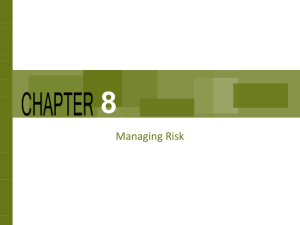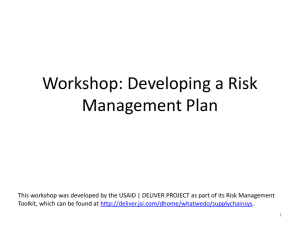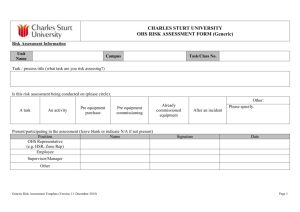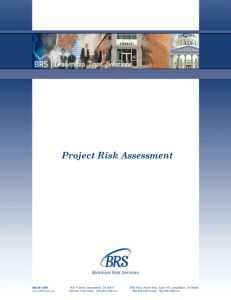Understanding and Managing Supply Chain Risk
advertisement
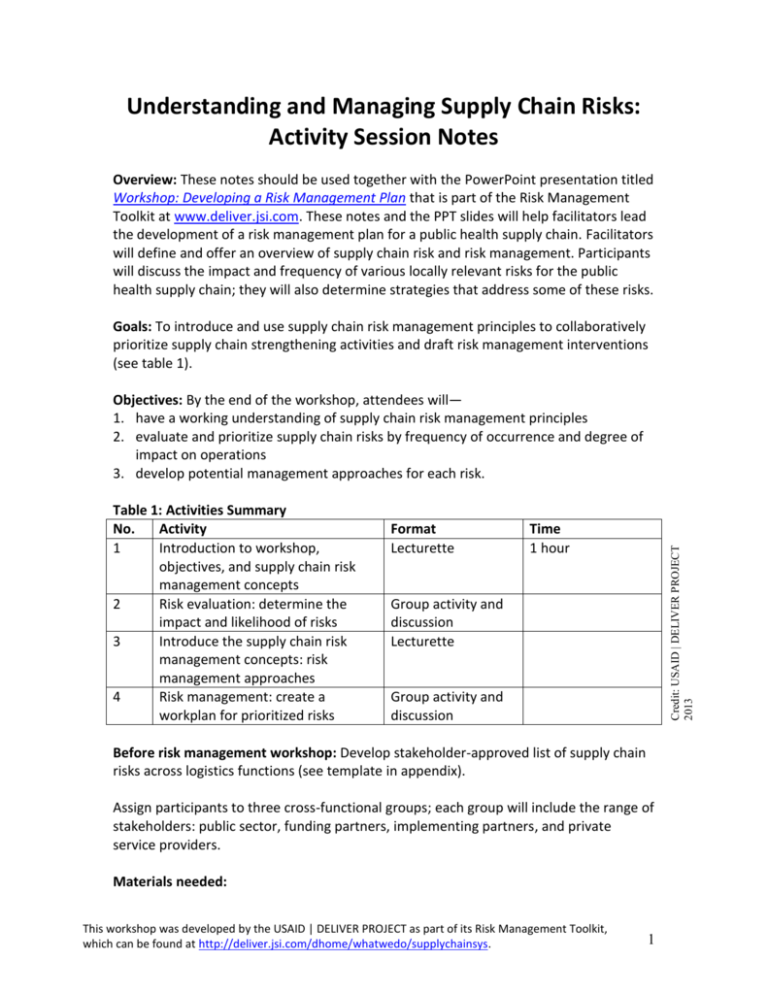
Understanding and Managing Supply Chain Risks: Activity Session Notes Overview: These notes should be used together with the PowerPoint presentation titled Workshop: Developing a Risk Management Plan that is part of the Risk Management Toolkit at www.deliver.jsi.com. These notes and the PPT slides will help facilitators lead the development of a risk management plan for a public health supply chain. Facilitators will define and offer an overview of supply chain risk and risk management. Participants will discuss the impact and frequency of various locally relevant risks for the public health supply chain; they will also determine strategies that address some of these risks. Goals: To introduce and use supply chain risk management principles to collaboratively prioritize supply chain strengthening activities and draft risk management interventions (see table 1). Objectives: By the end of the workshop, attendees will— 1. have a working understanding of supply chain risk management principles 2. evaluate and prioritize supply chain risks by frequency of occurrence and degree of impact on operations 3. develop potential management approaches for each risk. Format Lecturette Time 1 hour Credit: USAID | DELIVER PROJECT 2013 Table 1: Activities Summary No. Activity 1 Introduction to workshop, objectives, and supply chain risk management concepts 2 Risk evaluation: determine the impact and likelihood of risks 3 Introduce the supply chain risk management concepts: risk management approaches 4 Risk management: create a workplan for prioritized risks Group activity and discussion Lecturette Group activity and discussion Before risk management workshop: Develop stakeholder-approved list of supply chain risks across logistics functions (see template in appendix). Assign participants to three cross-functional groups; each group will include the range of stakeholders: public sector, funding partners, implementing partners, and private service providers. Materials needed: This workshop was developed by the USAID | DELIVER PROJECT as part of its Risk Management Toolkit, which can be found at http://deliver.jsi.com/dhome/whatwedo/supplychainsys. 1 Understanding and Managing Supply Chain Risks: Activity Session Notes PowerPoint projector PowerPoint slides and/or printed slides Handout: Supply chain risk management briefs (infographics), risk evaluation, and treatment template Flip chart and marker. Activity 1: Workshop Introduction Introduce facilitators: review agenda and objectives. Welcome participants: Ask participants if they ever face challenges from the weather— getting wet when it rains, facing difficult traffic when it rains? Do they check the weather forecast? Do they carry an umbrella? Do they ignore the possibilities? Why? What are the consequences? Participants can also be asked these questions as they arrive; share the responses at the opening of the session. Compare and summarize responses; conclude by noting that the chance of being caught outside in the rain is a risk; and that predicting, preparing (or choosing not to prepare) for risks is a universal activity, even if this decisionmaking process is in the background. Explain to participants that this workshop is about extending and formalizing this concept for the public health supply chain context. The workshop will focus on supply chain risk management for the public health setting. We will use participant knowledge to determine which risks pose particular threats to system performance, and to draft approaches for managing these risks—by either choosing to monitor and predict risk occurrence (checking the weather), developing contingency plans (carrying an umbrella), or deciding the risk does not pose enough of a threat to warrant action. Present the goal and objectives of the workshop: Learn the basic concepts of supply chain risk management. Use a risk evaluation exercise to prioritize potential risks to participants’ supply chain. Use a collaborative approach to propose interventions to manage high-priority risks. Ask if anyone has a question about these objectives. Present the agenda for the workshop. Share slide 5. Focus on the first component of risk management—identifying risk. Read the definition of risk, including the example of unexpected rain; and other everyday examples—running out of fuel in your vehicle, having your vehicle break down, or having your house flood. These situations present undesirable consequences—they 2 Understanding and Managing Supply Chain Risks: Activity Session Notes prevent us from achieving daily goals, such as reaching our destination or keeping our house in good condition. Ask for one or two more daily life examples. In the next step, extend these examples to the public health supply chain. Ask participants to name a few basic goals of the public health supply chain, or draw a few examples from existing documents. Write them on a flip chart and ask participants to validate them. Then ask participants what types of events could prevent the system from achieving these goals. Take several examples and write them on the flipchart. If examples are too similar, encourage diversity in examples that cover general performance dysfunction and external disruptions. For example, late donor funds can reduce stock availability and require attention for rationing and redistributing available stock to reduce the effects of low stock availability. In some cases, risk events lead to dysfunction; that is, deviations from expected or normal supply chain performance. In other cases, it results in disruption, or a complete breakdown, in supply chain performance. In our example, late donor funds would probably lead to dysfunction; while completely suspended donor funds would probably lead to disruption. Reiterate to participants that the goal of this workshop is to help institute risk management approaches within their supply chain. Show slide 6: Risk Management Schematic. Explain that risk management is a series of iterative steps. Briefly review the diagram and each step; point out that participants’ work in this workshop will be the risk evaluation and will prepare their system for ongoing risk management. Show slide 7: Why is risk management important? Formalized risk management helps supply chains focus strengthening resources and, collaboratively, develop management approaches that lessen the impact or frequency of undesirable events. It helps align stakeholder activities around shared information and makes the supply chain more agile and responsive to unforeseen events, all leading to improved performance. Supply chain risk management is an established and growing concept in the commercial sector, especially for complex supply chains; for example, supply chains spanning multiple countries, with multiple levels or tiers of suppliers, or products with critical components. Share commercial sector examples, including outcomes. Public health supply chains have also adopted these practices. List cited examples. The procurement unit within the USAID | DELIVER PROJECT has taken a comprehensive risk management approach to help achieve its goal of better on-time delivery. Refer to the case study handout as an example; if time allows, discuss the case study and outcomes as a group. Activity 2: Risk Evaluation Show slide 10: Sources of public health supply chain risk. Crucial to the process of risk management is identifying risks that should be addressed proactively to avoid more costly reactive problem-solving in the future. 3 Understanding and Managing Supply Chain Risks: Activity Session Notes Sources of risk that can result in both disruption and dysfunction include— complexity arising from intrinsic characteristics of both the disease and health commodities poor quality and availability of data for analysis and decisionmaking complexity of activities, procedures, and analyses for decisionmaking and control (procedural complexity) poor quality of collaboration between decisionmakers and stakeholders poor management fundamentals and insufficient resource levels for operational systems changes within the local and global economy local and international politics health policy decisionmaking, both locally and globally resource destruction/theft natural events. Introduce the preconstructed list of supply chain risks, which should comprehensively include the risk events that stakeholders want to consider for collaborative prioritization, categorized by logistics function. Ask for consensus on whether any risks should be added or combined. After it is finalized, move this list to a visible location (if on a flip-chart). Show slide 11: Risk Evaluation. Now that participants are familiar with the basic concepts of risk management, they can apply these concepts to their supply chain. Refer back to the risk management schematic, if necessary, to show how participants’ work in this meeting fits within the broader risk management process. One way to evaluate and categorize supply chain risks is to account for their severity (impact) and their likelihood of occurrence (frequency) of each risk. Prioritize for management’s attention any risk event that is more likely to occur, and that pose a greater threat to achieving the goals of the organization, health program, or supply chain. Low High Credit: USAID | DELIVER PROJECT 2013 High Tsunami Low Likelihood With the two ways of describing risk, the following matrix can be used as a framework for categorizing risks: 4 Understanding and Managing Supply Chain Risks: Activity Session Notes Impact The example of a tsunami is placed in the low occurrence, high-impact quadrant. A tsunami may rarely occur at a manufacturing plant on the coast of Australia, but it can have a catastrophic impact if it does occur. Show slide 12. Present the evaluation exercise directions to participants: Ask each group to select a reporter, review the list to ensure they understand each risk; then, for each risk, agree on and assign the estimated likelihood of occurrence (frequency) and severity of impact. As an example, the tsunami may have a likelihood of 0 or 1 in a particular area, but a potential impact of 4. If it occurred, it could completely disrupt the supply chain activities. Ask each group to agree on its scores; make sure that you include the perspectives of all the stakeholders represented. Allow 30 minutes for a group evaluation. Collect each group’s responses; enter them in a table that can be displayed for the plenary. If at least one group deviates by more than 3 points, in either frequency or impact for any risk, ask all the group reporters to explain— 1. Why was the particular risk placed in a particular segment of the matrix? How was the determination made? 2. What factors were considered? 3. Did you review past occurrences in your setting? If necessary, adjust group scores, if the groups agree. After the group scores are reviewed and agreed upon, for each risk, average the group frequency and impact scores. Then, for each risk, to calculate the risk priority number (RPN), multiply the average frequency and the average impact. Display the final table with the RPN for each risk. This number reflects the average view across the stakeholders present in the workshop, and provides a single metric for each risk, accounting for both its likelihood of occurrence and its impact. The maximum RPN in this approach is 16, while the minimum is 1. Ranked in order of RPN, the list shows participants where they should focus risk management resources. Suggest to participants that they adopt a cutoff point; agreeing, for the following funding year, to ignore risks below the cutoff point and focus only on 5 Understanding and Managing Supply Chain Risks: Activity Session Notes those that pose a greater threat to operations. Propose a cutoff RPN score of 5; note, with participants, which risks to focus on and which to leave for a later workplan. Activity 3: Lecturette: Introduction to supply chain risk management approaches Show slide 15. Faced with a world with increasing variability and volatility, business managers from a wide range of sectors and contexts have been subtly shifting their operations outlook from just asking the question—“How do we get our operations right?”—to also asking, and, in some places, only asking the question—“What is our plan for when things go wrong?”Although, ideally, the first question should also incorporate aspects of the second; in practice, this does not consistently happen. The former question usually results in a few modes of operation geared for normal expectations. However, the latter tends to expand the number of planned modes of operations to include some that can address more abnormal realizations. Risk management is about developing deliberate approaches to reduce the likelihood of problems occurring, or reducing the impact if they occur. This can take place preemptively or reactively, but it requires decisionmaking at this stage to choose the approaches and tools to be used. Over time, the approaches developed will help reduce the risk profile of the supply chain (reflected in the RPN score), and improve performance. Show slide 16. For implementing risk evaluation, a rating scale of 1 to 4 is recommended for measuring impact and likelihood. For consistency, it is recommended that the interpretation of each scale response be made explicit by using a template available in the risk management toolkit; it can be a reference for everyone working in risk evaluation. Impact. The basis for interpretation of rating scales for impact should be an aspect of the overall supply chain mission objective. Here the maximum rating should map to the complete breakdown in the supply chain mission; while the minimum rating should map to a mild deviation from the mission. Likelihood. The interpretation of rating scales for likelihood should be based on frequency in a time period, e.g., a year or a month. The maximum rating should map to the most frequent occurrence of risk events in the supply chain, while the minimum rating should map to the least frequent occurrence of risk events. Show slide 17. In the risk evaluation exercise, participants were asked to name the factors that led to their particular rating for impact or likelihood. We refer to those factors as risk feature drivers. Those factors are specific to a risk feature for either impact or likelihood, although both impact and likelihood could share the same risk driver. Refer to some of the factors that were raised in the group risk evaluation as examples. These risk drivers are also risk-event specific, although different risk events can share the same drivers. Being able to indentify risk drivers for risk events implies a 6 Understanding and Managing Supply Chain Risks: Activity Session Notes better understanding of their mechanisms and, also, helps improve the consistency of risk-event evaluation. Finally, risk drivers will be important for risk monitoring and for performance monitoring. Review slide 18 again, noting that the next phase of the workshop will focus on preparing the prioritized risks from the Risk Evaluation stage for active, ongoing risk management. Show slide 19. Explain the following to participants: Reducing risks refers to approaches that directly seek to understand the sources of risk and to minimize these dynamics. Here the focus is on both dimensions of the source of risk and the logistics operational areas in which the risk event occurs. Examples of activities that reduce risk include efforts to understand the drivers of risk better, improve forecasting, and improve planning and execution of supply chain activities; and reduce the direct and opportunity costs within the supply chain to reduce the impact. Hedging risk refers to approaches that provide strategically placed resources within the supply chain to make the supply chain less susceptible to risk events. Holding safety stock is a type of hedging against the risk that supplier lead time or demand will unexpectedly increase. To hedge against potential increases in the price of fuel, transport companies may buy vehicle fuel under options contracts. Avoiding risk refers to approaches that change the dynamics of the supply chain to make it less susceptible to the particular sources of risk. While both hedging and avoidance focus on the operational areas of the supply chain, hedging is more riskevent focused, while avoidance is more focused on the sources of risk. In addition, hedging focuses less on reducing the likelihood of the event happening and more on reducing the impact of the event after it occurs. Examples of activities that avoid risk include designing the supply chain (e.g., short lead times), or health commodity (e.g., commodities tolerant of high temperatures), to eliminate complexities related to supply system inefficiencies that create risk. Partners can also choose to accept risk by deciding not to take any preemptive action. This makes sense when the likelihood of occurrence, degree of impact, or both, are low enough that management resources are not warranted. Partners have accepted the risk events that fell below the RPN cutoff earlier in this workshop. Understanding these general approaches, the next step is to decide which approach best fits particular risks. Show slide 20. Explain to participants that, ultimately, a risk response must make economical sense in terms of a cost benefit analysis; however, the general nature of the 7 Understanding and Managing Supply Chain Risks: Activity Session Notes risk event tends to suggest particular risk responses, compared to others. In particular, three features of the risk event combine to identify an appropriate risk response: Is the source of risk controllable? Is the source of risk operational? Is the source of risk structural? Controllable sources of risk are those under the control of the supply chain manager and her team. Operational sources of risks refer to risks that result from health supply chain decisionmaking and activities. Both types of risks lend themselves to reducing a risk response. Structural sources of risk refer to risks from the design of the health supply chain systems and the strategic relationship between decisionmakers and actors. These risks lend themselves to an avoidance response through the redesign of the supply chain and the relationships. When risks are uncontrollable, or avoiding risk is not possible because of structural properties, hedging risk is more appropriate. Show slide 21. Risk monitoring refers to two types of monitoring. The first type is monitoring the risk features to confirm if the original risk treatment plan is appropriate. This type of monitoring is particularly important for high-impact low-likelihood risk events that may have had any risk treatment strategy created for them. If the likelihood were to increase for these risk events, they would need to be treated differently. The second type of risk monitoring is to see if a risk event is imminent. This type of risk monitoring can provide advanced notice of the events occurring and allow more effective response to mitigate impact. Both types of monitoring include monitoring risk feature drivers; they are usually identified during the risk evaluation and risk treatment process. An example of monitoring for an imminent risk event is tracking the number of units ordered in a procurement cycle compared to a benchmark. This data could provide an indication of when an emergency order is more likely to occur. Show slide 22. Risk performance monitoring does create some challenges for traditional supply chain performance measurement. Traditional key performance indicators (KPIs), which capture how the supply chain is functioning, tend to be affected by a range of risk events; they may not be able to capture the effects of low impact or low likelihood events. As a result, risk performance monitoring requires additional options, including the use of diagnostic metrics that better explain why the supply chain is performing the way it is; they are usually affected by a smaller set of risk events, rather than traditional KPIs. The change in risk feature drivers can also be used for performance measurement; because these factors are expected to directly influence risk features, like impact and likelihood. Finally, in some cases, when risk events do not occur frequently enough, simulation or forecasting of performance under risk treatment strategy is the only proxy for performance measurement. Here, simulation can be focused on the change in risk 8 Understanding and Managing Supply Chain Risks: Activity Session Notes features—e.g.—impact or likelihood, as a result of risk treatment strategies; or it can more directly simulate the effect on the supply chain of the unmitigated versus mitigated event. Show slide 23. Examples from the TO5 case study for performance monitoring. Examples of diagnostic metrics include the delivery to plan reasons for late shipments, and warehouse metrics that give the percentage of deliveries that were late, for each category of reasons. Examples of simulated performance include the estimation of changes in risk features, which result from particular risk responses. Activity 4: Drafting risk management approaches. Split participants into functional groups: procurement, warehousing, forecasting, distribution, etc. To propose a basic approach—avoiding, reducing, hedging—recommended actions, parties responsible, data/metric used for monitoring, and management timeline, ask each group to review all the prioritized risks for that particular functional group. Include a timeline for finalizing the tools in the management timeline. Participants can use the Risk Evaluation and Treatment template from the risk management toolkit. To minimize time, participants can focus on the risk treatment section of the template; but, they should examine the other sections of the template to see how they relate to activities that the participants have already been engaged in. In the plenary, to approve a draft risk management plan, ask the groups to review the proposed plans and to identify areas for collaboration or sharing of data to improve monitoring efforts. 9 Understanding and Managing Supply Chain Risks: Activity Session Notes Appendix: Risk Table Template Before going through a collaborative prioritization exercise, partners should jointly compile (for example, by email) a list of relevant risks to their supply chain. Individual supply chain practitioners with appropriate experience will probably understand the risks their supply chains face. However, developing a list based on multiple stakeholders’ views will help confirm the importance of risks identified by the multiple stakeholders; it will, also, identify risks that could, potentially, be overlooked. This list (see figure 1) should comprehensively include risks from a variety of sources, including— complexity from the intrinsic characteristics of both the disease and health commodities poor data availability and quality for analysis and decisionmaking within operational areas and within the risk management activities complexity of activities, procedures, and analyses for decisionmaking and control (procedural complexity) poor quality of collaboration between decisionmakers and stakeholders poor management fundamentals and insufficient resource levels for operational systems. Credit: USAID | DELIVER PROJECT 2013 Figure 1: Common sources of risk in public health supply chains Sources of Risk for Both Disruption and Dysfunction Additional sources of risk that tend to result in disruption include (1) changes within the local and global economy; (2) politics; (3) health policy decisionmaking, both locally and globally; (4) resource destruction/theft; and (5) natural events. 10 Understanding and Managing Supply Chain Risks: Activity Session Notes Examples of Typical Sources of Risk Two groups of health commodities that receive significant attention in developing countries are low stockout tolerance commodities—antiretrovirals (ARVs)—and commodities with special supply chain needs—vaccines requiring cold chain. The sources of risk that tend to have high impact for these commodities are listed in table 2. Table 2: Source of Risk with a High Impact on Commodities Special Supply Chain Needs Timely data for consumption, inventory levels in the Infrastructure (e.g., redundancy) supply chain and stockouts Inventory levels in the supply chain Monitoring and maintaining supply chain infrastructure Low levels of capabilities from turnover and poor training Funding for procurement and maintenance of supply chain infrastructure Seasonality Nature Poor supply chain control design Resource theft/destruction. Health policy decisionmaking Nature (e.g., supplier production accidents) Economic (e.g., incentives for supplier competition and sustainability) Use table 3 as a template for partners to complete: Table 3: Template for Partners Inventory Logistics Funding Risk Events Health Systems Patient Related Other Credit: USAID | DELIVER PROJECT 2013 Source of Risk (example, System management, health complexity) 11 Credit: USAID | DELIVER PROJECT 2013 Low Stockout Tolerance Commodity


